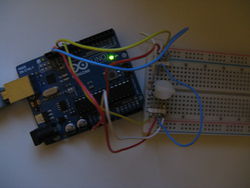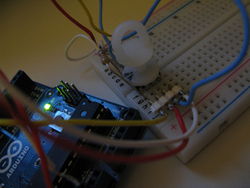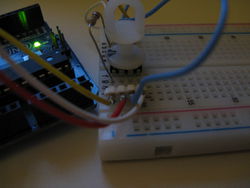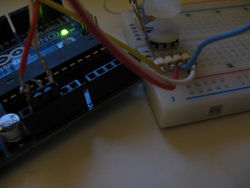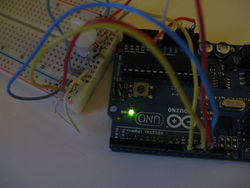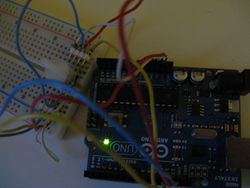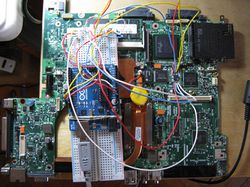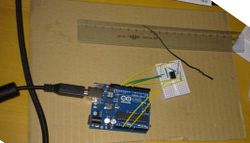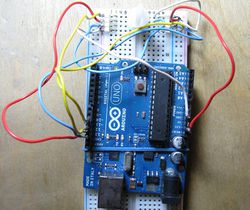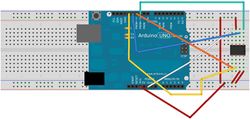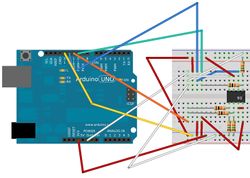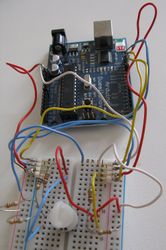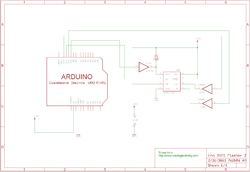Serprog/Arduino flasher
This wiki is retired
Our website is https://www.flashrom.org, instructions on how to add or update documentation are here
All wiki content available in read-only mode at wiki.flashrom.org
WARNING,if you don't add the resistors, the SPI levels are at 5V, while I tried it with 3.3V chip and that it worked(but DIO was at 4.3v which was over the maximum of 4v, during all the time that the chip was connected to the programmer), it may not work for you and break the chip...
This flasher require the following hardware parts:
- An arduino uno or an arduino Duemilanove(way faster) and its usb cable
- some wires(optionally some connectors to solder on(for easier plugin and more reliability)
a 10k resistor- 3 x 10k resistors (for the 3.3v version)
- 3 x 15k resistors (for the 3.3v version)
- A flash chip with the following characteristics:
- supported by flashrom
- SPI
- 3.3v or 5v(the arduino has a 3.3v and a 5v output, only 3.3v was tested...)
Pictures (With the 5V SPI levels issue)
- Pictures
-
-
-
-
-
-
-
Because of the long cables flashrom had to retry once before reflashing the BIOS but at the end it worked. So don't use cables that are that long...
-
Setup by Sebastian Parborg (DarkDefender)
-
It now seem to also work without resistor...
Building (With the 5V SPI levels issue)
Left pins of the BIOS chip: -------------------------------------------------------- [pin1 of the bios chip] /CS<->10k resistor<->VCC [pin1 of the bios chip] /CS<->Arduino pin10(SS, PORTB2) [pin2 of the bios chip] DO<->Arduino pin12(MISO, PORTB4) [pin3 of the bios chip] /WP<->VCC [pin4 of the bios chip] GND<->GND on the power pins Right pins of the BIOS chip: -------------------------------------------------------- [pin8 of the bios chip] VCC<->+3.3V on the power pins of the Arduino [pin7 of the bios chip] /HOLD<->VCC [pin6 of the bios chip] CLK<->Arduino pin13(SCK, PORTB5) [pin5 of the bios chip] DIO<->Arduino pin11(MOSI, PORTB3) The Bios chip used is a W25X80. The Arduino is an arduino uno.
Pictures (With the 3.3V SPI levels)
WARNING, I was told that by Simon Inns by mail: "The 3V3 fritzing example on the Wiki (the diagram of the breadboard) is quite wrong... The 3V3 output from the Uno is shorted to GND and the CLK and DI pins of the EEPROM are connected together after the 10K resistors. Might be a good idea to fix it before you get "You broke my Uno" emails ;)"
- Pictures
-
-
Improved 3.3v version by Simon Inns (no issue anymore with laptop chips)
Software
Settings
| git branch | Compatible Arduino version | flashrom arguments | Comments |
|---|---|---|---|
| master |
|
-p serprog:dev=/dev/ttyACM0:2000000 |
|
| ftdi |
|
-p serprog:dev=/dev/ttyUSB0:2000000 |
|
| leonardo |
|
Untested |
|
Performances
# time flashrom -p serprog:dev=/dev/ttyACM0:2000000 -r coreboot.rom flashrom v0.9.5.2-r1541 on Linux 2.6.38-14-generic (x86_64) flashrom is free software, get the source code at http://www.flashrom.org Calibrating delay loop... OK. serprog: Programmer name is "serprog-duino" Found Winbond flash chip "W25X80" (1024 kB, SPI) on serprog. Reading flash... done. real 0m16.602s user 0m0.930s sys 0m0.000s
# time flashrom -p serprog:dev=/dev/ttyACM0:2000000 -w build/coreboot.rom flashrom v0.9.5.2-r1541 on Linux 2.6.38-14-generic (x86_64) flashrom is free software, get the source code at http://www.flashrom.org Calibrating delay loop... OK. serprog: Programmer name is "serprog-duino" Found Winbond flash chip "W25X80" (1024 kB, SPI) on serprog. Reading old flash chip contents... done. Erasing and writing flash chip... Erase/write done. Verifying flash... VERIFIED. real 0m39.548s user 0m2.650s sys 0m0.000s
Required software
To make it work you need:
- flashrom from svn
- serprog-duino which runs on the arduino
- The avr toolchain(avr-gcc, avr-libc,make etc...)
Building the software
$ svn co svn://flashrom.org/flashrom/trunk flashrom $ cd flashrom && make $ cd ../ $ git clone git://gitorious.org/gnutoo-personal-arduino-projects/serprog-duino.git $ cd serprog-duino && make && make upload
Running flashrom
./flashrom -p serprog:dev=/dev/ttyACM0:2000000
Chips
- SST25VF016B => huge issues, not recognized by the 3.3v version, had to use the 5v version which is over maximum allowed voltage, also had to lower the serial speed to 115200, ultra slow to write(seem related to the chip itself, since that with the openmoko programmer it's even slower...)...
- W25X80 works well in 3.3v mode(5v works also but it's highly not advised to use 5v)
Advantages and disadvantages
The speed isn't that great(about 3 minutes for reading+writing+verifying a 1M chip)- The speed is now much better thanks to a patch by Sebastian Parborg.
- it is made of very commonly available parts(if you can find an arduino uno, you will be able to build it).
Voltage issues( SPI levels are at 5v, it's problematic for flashing 3.3v chips...)
TODO
Find a way to lower the voltage to 3.3v- Fix the arduino UNO speed and reliability issues
